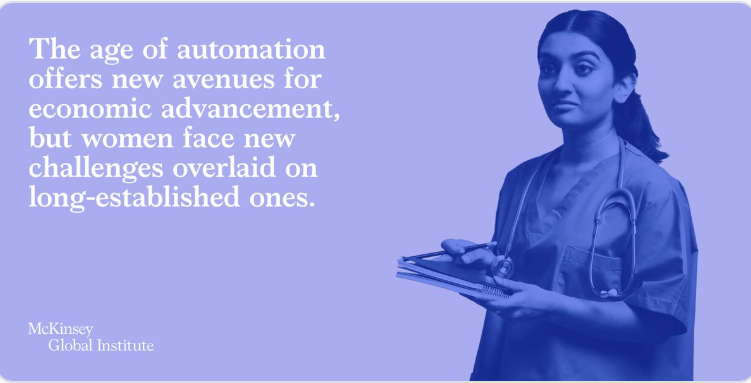Automation to push 40-160 m women for occupational transition by 2030: Study
The estimate presented in the Women Deliver Conference 2019 today at Vancouver, Canada; is based on the study of six mature economies (Canada, France, Germany, Japan, the United Kingdom, and the United States) and four emerging economies (China, India, Mexico, and South Africa), which together account for around half of the world’s population and about 60 percent of global GDP.

- Country:
- Canada
The age of automation, and on the near horizon, artificial intelligence (AI) technologies offer new job opportunities and avenues for economic advancement, but women face new challenges overlaid on long-established ones. Between 40 million and 160 million women globally may need to transition between occupations by 2030, often into higher-skilled roles. To weather this disruption, women (and men) need to be skilled, mobile, and tech-savvy, but women face pervasive barriers on each and will need targeted support to move forward in the world of work.
A new McKinsey Global Institute (MGI) report, ‘The future of women at work: Transitions in the age of automation (PDF–2MB)’, finds that if women make these transitions, they could be on the path to more productive, better-paid work. If they cannot, they could face a growing wage gap or be left further behind when progress toward gender parity in work is already slow.
This new research explores potential patterns in “jobs lost” (jobs displaced by automation), “jobs gained” (job creation is driven by economic growth, investment, demographic changes, and technological innovation), and “jobs changed” (jobs whose activities and skill requirements change from partial automation) for women by exploring several scenarios of how automation adoption and job creation trends could play out by 2030 for men and women given current gender patterns in the global workforce.
These scenarios are not meant to predict the future; rather, they serve as a tool to understand a range of possible outcomes and identify interventions needed. We use the term jobs as shorthand for full-time-equivalent workers.
The findings of the report could be summarized as under:
Men and women tend to cluster in different occupations in both mature and emerging economies, and this shapes how each is likely to be affected by automation. For instance, in many countries, women account for more than 70 per cent of workers in healthcare and social assistance, but less than 25 per cent of machine operators and craft workers.
In a scenario where automation unfolds on the scale of past technological disruptions, women and men could face job displacement and potential job gains of broadly similar magnitude. In the ten countries studied, an average of 20 per cent of working women (107 million)could lose their jobs to automation versus 21 per cent of men (163 million) by 2030. Rising demand for labour could imply 20 per cent more jobs for women, compared with19 per cent for men, assuming their shares of sectors and occupations hold. Entirely new occupations will also be created, but approximately 60 per cent of new occupations have been in male-dominated fields.
However, the composition of potential job losses and gains for men and women could be different. Service-oriented and clerical support occupations could account for 52 per cent of women’s job losses, but machine operation and craftwork occupations could account for 40 per cent of men’s losses. Women are well represented in fast-growing healthcare, which could account for 25 per cent of potential jobs gained for women, while manufacturing could account for 25 per cent of jobs gained for men.
Worldwide, 40 million to 160 million women—7 to 24 per cent of those currently employed—may need to transition across occupations (the wide range reflects different paces of automation). For men, the range is comparable at 8 to 28 per cent. If women take advantage of transition opportunities, they could maintain their current share of employment; if they cannot, gender inequality in work could worsen.
To make these transitions, women will need new skills. In mature economies, only jobs requiring a college or advanced degree may experience net growth in demand. In emerging economies, the many women working in subsistence agriculture with little education may have difficulty securing work in other sectors. Even women remaining in their current jobs will need to refresh their skills; they could be more prone than men to partial automation of their jobs and will need to learn to work alongside automated systems.
The researches forecast that the responsibilities of the family would make it harder for women to make transitions because they have less time to reskill or search for employment as they are less mobile due to physical safety, infrastructure, and legal challenges; and have lower access to digital technology and participation in STEM fields than men. It has been recommended that the policymakers and businesses need to step up interventions, some targeted at women, to overcome these barriers. High priorities include more investment in training and transitional support; more provision of childcare and safe and affordable transportation; addressing stereotypes about occupations; boosting women’s access to mobile internet and digital skills in emerging economies; and supporting women in STEM professions and entrepreneurship.
ALSO READ
IFC Powers Climate Finance and Gender Equality with $400 Million Boost
Abhishek Banerjee to Attend Gender Equality Exchange in Norway
Beyond the Tag: Prioritizing Impact in Gender Equality Initiatives at the World Bank and IFC
Breaking Barriers: The Ongoing Struggle for Gender Equality in U.S. Politics and Beyond
Advancing Gender Equality Through Social Protection: World Bank's New Strategy










